By Adrian Siverson
January 2016
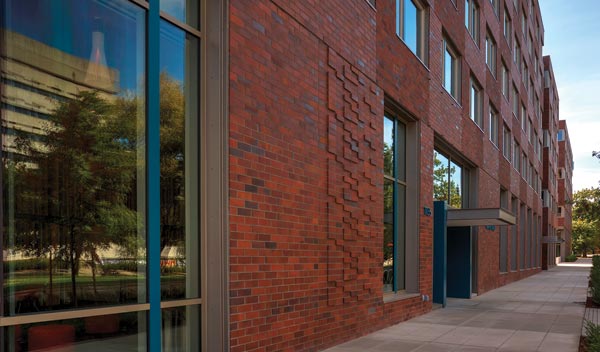
Building Information Modeling (BIM) seems to be the hot topic lately. It is being talked about in one way or another in most construction publications and on social media platforms. Is it just a buzzword? Can it be implemented in masonry? If implemented, does it offer any value to the mason contractor? These are the questions I hear most when speaking about our involvement in BIM.
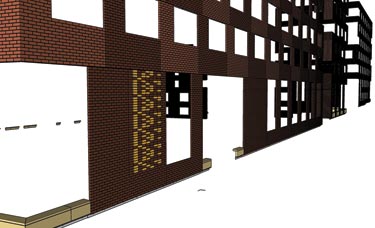 We initially started our BIM involvement on projects by simply creating 3D shapes of specialty brick to send to our supplier, for confirmation that they could be made. We would also make a small 3D model of the shapes to assure they worked with the layout and bond we were trying to accomplish. This was beneficial to the supplier and the mason; reducing cuts, fabrication and install time (see Image 1).
We initially started our BIM involvement on projects by simply creating 3D shapes of specialty brick to send to our supplier, for confirmation that they could be made. We would also make a small 3D model of the shapes to assure they worked with the layout and bond we were trying to accomplish. This was beneficial to the supplier and the mason; reducing cuts, fabrication and install time (see Image 1).
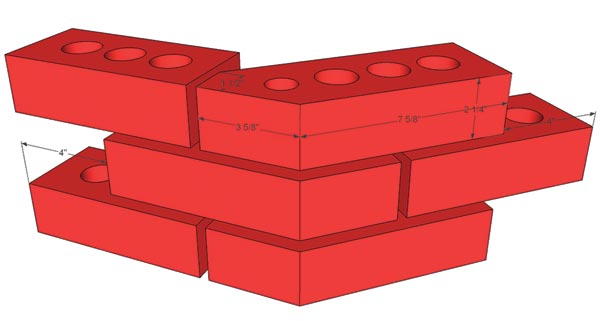
From there, we became involved with making a BIM brick mockup similar to a mockup panel (see Image 2). It showed the brick layout, coursing, flashing, relieving angles, and back-up wall. The model identified the areas that did not work and areas needing more detail. The payoff was that when the building was built, there were no issues with the modeled components.
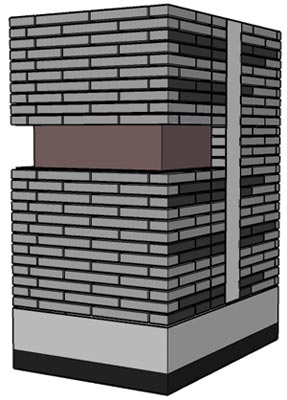
Modeling the mockup greatly reduced problems with the different materials interfacing with the brick veneer. Those materials were supplied and installed by other subcontractors. Our crew’s productivity increased, because they were able to continue laying brick without the associated starts and stops typical to other subcontractors interfacing with our work.
Our first large BIM project was modeled solely as a contract requirement (see Image 3). We modeled what the general contractor/construction manager (GC/CM) needed. The model was essentially used for clash detection between mechanical, electrical, fire and structural elements (our model was structural CMU). The model looked good, but it did not provide the information to really help our crew in the field. We did not provide the model or any of the information to our crews in the field.
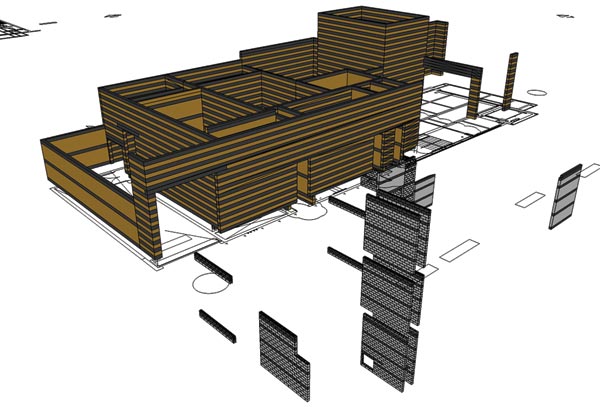
The GC/CM did not provide or make available any of the information for their crews in the field. We did get some benefits from the model: RFIs were identified early, and clashes that usually occur and stop the masonry crew were identified and corrected before we started on the project.
What we learned
What we have learned is that the most beneficial way to implement BIM in masonry is to model what we want to see in the level of detail we need. That way we can produce drawings that make our crews more productive and lessen the time our foremen spend searching for information in the architectural plans. By modeling, we know immediately if something doesn’t work. We can find a solution before starting work on the project. Our models are represented in a set of masonry shop or lift drawings that we provide to our crews (see Image 4).
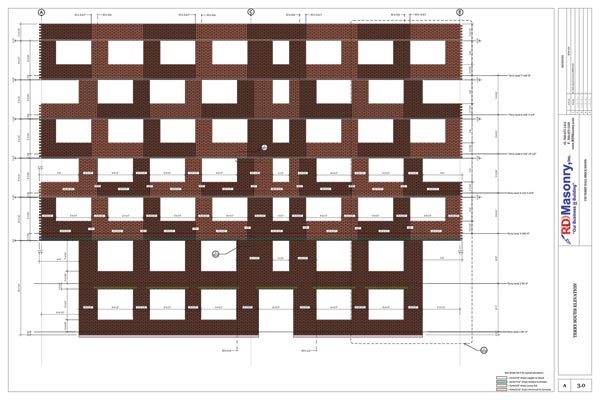
Today, we create BIM models for several applications.
- When it is a contract requirement
- When masonry shop or lift drawings are required
- When we need to represent tough details in the masonry
- When it benefits us on the project.
Anything that we used to do in 2D, such as shop drawings, is now done in 3D and converted to 2D and isometric plans. When modeling a structural CMU wall, we will show the rebar dowel layout, saving us time by not having to lay it out in the field for the other trades and getting it in the right spot from the start.
I try to model multiple elements, like brick that interfaces with angle irons or precast. I include them in the same 3D model, ensuring proper fit and layout. Modeling these elements helps confirm the layout works both horizontally and vertically, and that the parts interface correctly. We include these elements in the masonry model when we are supplying them and use the plans from the model for the shop drawings. When precast and angle irons are modeled with the brick or CMU, we know it fits and the attachments work, which equals better production.
During the modeling process, if we find a door, window, ledger angle, or some other building element that does not work to the layout or design that we or the architect typically like to see, we will create an RFI to move or change them. Identifying layout issues early in the design greatly reduces lost time during actual construction. This is especially true when the design team is willing to work with the mason and incorporate the BIM masonry model. The key here is to leverage the model to get the most out of its data and your efforts.
When you start working with BIM models, you learn that a lot of time can be spent repeatedly drawing things. I have learned to use shapes I have used in the past for projects I am doing today. During the last five years, I have amassed an extensive library of components/families that I am able to use on future projects. I store them in a folder, so I can quickly grab them for use in a model.
When landing a project, one of the first things I do is request a set of PDF plans. If it is a project for which I am going to create a BIM masonry model, I also request the CAD backgrounds of the floor plans. Instead of having to draw and layout all the masonry walls, I can import the CAD drawings into the BIM model and create the walls from the layout already provided by the architect. I try to reuse the wheel, not reinvent it (see Image 5).
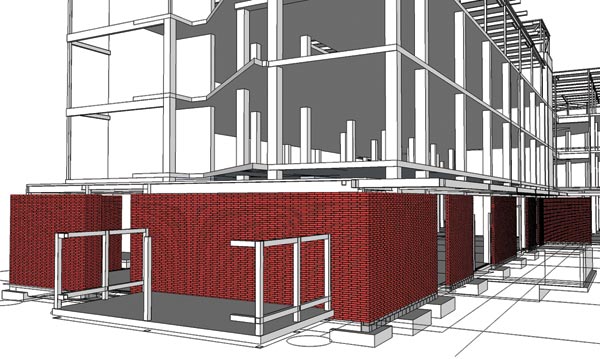
When I model, I find it important to understand the materials, installation process, and how they interface with each other. Having worked in the field myself, both as a bricklayer and a foreman, I have a good understanding of our trade. I try to transfer that masonry-specific knowledge to the BIM model. This includes material sizes, shapes, layout, 3D scheduling, material procurement, and shop drawing design. All the while, I ensure that the model is used to reduce crew stoppages, material overages, and costs – while maximizing production, simplifying layout dimensions, and using the RFI process. I provide detailed drawings to our crews, foreman, GC and design team, so the BIM model is leveraged to its fullest potential.
The takeaway from our experiences
So is Building Information Modeling a hot topic? Yes. We have communication about it on more than half of our projects. The GCs and architects have been receptive and positive about our ability as a company to be a part of the BIM process. We have actually been asked afterward to provide BIM models and have been paid extra for the service.
Can BIM be implemented in masonry? As a company, we are now at a point that we have several projects involving some level of BIM at any given time. We have learned to utilize our models to their fullest potential and have had success implementing BIM into our daily operations. Our crews know what BIM is, and they are familiar with the type of information the model can provide them. They are not fearing the future, but are welcoming it.
If implemented, does it offer any value to the mason contractor? Mason contractors really measure success on production. We needed to show that, when we used BIM, we had fewer problems on the project. Whether those problems were ours or another trade’s, by eliminating them, we were more productive.
Simplifying the layout and dimensions on our shop and layout drawings increases production and lessens returns to correct deficient work. The model can provide exact quantities, greatly reducing waste. In the end, the GC and design team are happy with the involvement of our company and always include us in conversations of upcoming projects.
As an industry, we have lost some ground to competing systems as those industries have embraced BIM. Architects and designers want to go out and download parts, pieces and details for a project. Parts, pieces and details, they can get from competing systems, but not masonry. They want GCs and their subcontractors to be part of a collaborative effort. Part of that effort today is the provision of information through a BIM model.
Masonry, as an industry, is falling behind in the information we are providing to design teams. Technology, as it pertains to construction, is advancing at a rapid rate. Early adopters tend to have an edge in what services they provide to a project.
What can we do, as an industry, to be early adopters, implement technology, and be a front runner as a system of choice when designing buildings? For us, that step has been adopting BIM as a part of our operation. Masonry is timeless. BIM for masonry’s time has come.
Adrian Siverson is project manager and BIM coordinator for R&D Masonry Inc., www.rdmasonry.com.